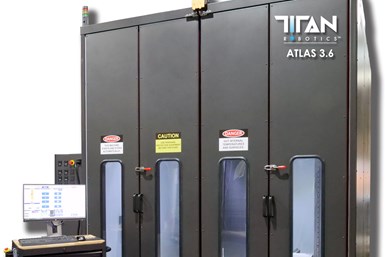Titan Robotics Launches Large-Format Atlas 3D Printer
Industrial printer features extrusion technology and an actively heated enclosure, enabling customers to print large parts using high-performance materials.

Titan Robotics Atlas 3.6 3D printer
Titan Robotics Ltd. is taking industrial large-format 3D printing to greater heights with the launch of its largest system, the Atlas 3.6. The company says the printer features a build volume of 50" × 50" × 72", state-of-the-art pellet extrusion technology and an actively heated enclosure, enabling customers to print large parts out of high-performance materials, including CF-PEI, GF- PEKK, nylons, ABS and more.
The Atlas 3.6 is designed to handle the additional weight and size of the machine, making it compatible with Titan’s Dual Pellet Extrusion and Hybrid Pellet + Filament Extrusion systems. Built with a heavy-duty, rigid design and powerful components, the Atlas 3.6 is said to maintain accuracy and fast rapid travel speeds with the larger print area. With this large build size, customers can print large parts as is without needing to slice parts into multiple sections for printing and then trying to assemble it post-printing.
With an actively heated chamber reaching 80°C and several extrusion configuration options, the Atlas 3.6 provides solutions across a range of applications, including large-format tooling, patterns and molds, and functional parts. It also features door safety interlocks and industrial CNC control system with closed loop servos on all axes.
Pellet extrusion on the Atlas enables production AM solutions by printing directly with plastic pellets instead of traditional filament. Pellet extrusion increases throughput and decreases material costs, while also expanding the variety of materials that can be 3D printed.
Available extrusion configurations include Dual Pellet Extrusion, Hybrid Dual Pellet + Filament Extrusion, Hybrid Single Pellet + Filament Extrusion, and Single Pellet Extrusion. The Atlas 3.6 is suitable for a variety of industries, including aerospace and defense, consumer appliances, foundry and more.
Related Content
-
3D Printing Brings Sustainability, Accessibility to Glass Manufacturing
Australian startup Maple Glass Printing has developed a process for extruding glass into artwork, lab implements and architectural elements. Along the way, the company has also found more efficient ways of recycling this material.
-
Evaluating the Printability and Mechanical Properties of LFAM Regrind
A study conducted by SABIC and Local Motors identified potential for the reuse of scrap reinforced polymer from large-format additive manufacturing. As this method increases in popularity, sustainable practices for recycling excess materials is a burgeoning concern.
-
Part Removal Efficiency In a 600 mm Plus World
Clay Olson of EDM Performance Accessories discusses the difficulties and opportunities in cutting off parts from the build plates of large AM systems. Molybdenum wire EDM offers an effective solution to the challenge of large-part cutoff.














